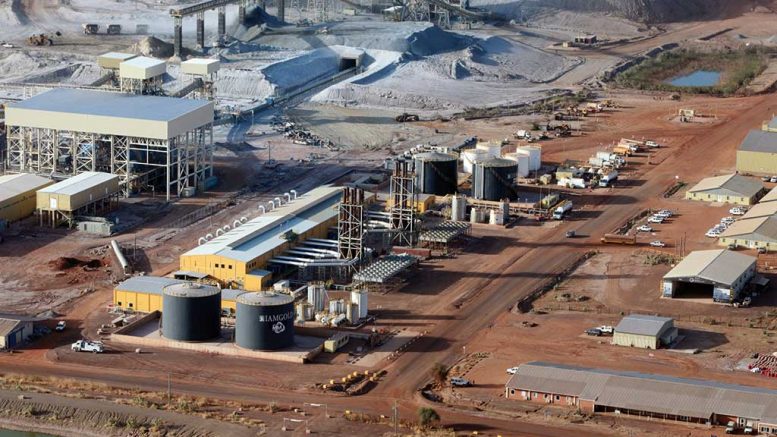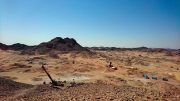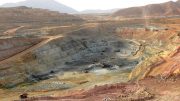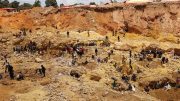It’s been a big year in West Africa for Iamgold (TSX: IMG; NYSE: AIG).
The company kicked off 2018 with high-grade assay results from its Siribaya gold project in Mali and completed a prefeasibility study on its Boto gold project in Senegal in February.
In March, Iamgold cut the ribbon on the world’s largest hybrid solar-thermal power plant at its Essakane gold mine in Burkina Faso, and in June wrapped up a prefeasibility study on heap-leaching, which showed Essakane’s mine life could be extended from 2023 to 2026.
In support of the heap-leach prefeasibility study, infill drilling to upgrade lower-grade inferred resources intersected higher grades than anticipated in several areas, and the results suggest more higher-grade mineralization zones for processing at the mine’s carbon-in-leach plant.
The company was unavailable for comment, but Steve Letwin, Iamgold’s president and CEO, applauded the Essakane team in a press release in June.
“Not only have they introduced a new processing method that allows for economic incremental production, their success at the drill bit has delivered a resource increase far greater than what we expected,” Letwin said in prepared remarks. “While we knew that heap leaching had the potential to unlock additional reserves, we were positively surprised at, and benefitted from, intercepting higher grades, which account for more than one-third of the 39% increase.”
Essakane’s probable reserves jumped 1.3 million oz. (39%) to 4.7 million oz., while indicated resources rose 19% (0.8 million oz.) to 5.1 million oz., and inferred resources surged 54% (0.2 million oz.) to 0.6 million ounces.
If a heap-leach operation is approved, average production would increase 16% to 480,000 oz. a year, according to the study. Initial capex would run to US$155 million.
The company has already started work on a feasibility study, which it expects to finish in the first quarter of 2019.
Farooq Hamed of Raymond James called the preliminary results encouraging, and better than his expectations. “While we had previously modelled an extended mine life in anticipation of results from the heap-leach prefeasibility study, our forecasted grades for the extension were lower than those achieved by the company, allowing for greater-than-expected production for the 2020–2026 time period,” he says in a research note. (The study prompted Hamed to hike his target price on the stock from US$7.25 per share to US$7.50 per share.)
This year, Iamgold forecasts that Essakane will produce between 380,000 and 395,000 oz. gold. Last year the mine produced a record 389,000 oz. gold.
In addition to the prefeasibility study, Iamgold marked another milestone with the start-up of a 15-megawatt-peak solar power plant. The solar plant will complement the existing 57-megawatt thermal power plant, making it the largest solar-thermal hybrid power plant in the world.
The mine is off-grid and relies on heavy fuel oil, due to its isolated location in the northeast of the country, 330 km from the capital, Ouagadougou.
The solar plant will cut the mine’s fuel consumption by 6 million litres a year and lower its annual CO2 emissions nearly 18,500 tons (16,800 tonnes). The plant, built in 10 months, is made up of nearly 130,000 photovoltaic panels, and is one of the largest solar facilities in sub-Saharan Africa.
After visiting Essakane on a June 12 site visit, mining analyst Andrew Kaip of BMO Capital Markets notes that the new solar plant supplies 10% of the mine’s power and has trimmed power costs from 22¢ per kWh to 17¢ per kWh.
“Once the 12-year amortization period for the solar plant is over, power costs would reduce to 9¢ per kWh,” Kaip wrote in a research note.
Iamgold is also drilling on concessions around Essakane, particularly its Gossey satellite prospect, 15 km north, where it hopes to finish a resource estimate in the fourth quarter.
Elsewhere in West Africa, a positive prefeasibility study on its Boto gold project in eastern Senegal estimated that an open-pit mine would produce nearly 100,000 oz. gold over a 13.5-year mine life.

Iamgold’s Essakane gold mine in Burkina Faso. Credit: Iamgold.
Direct cash costs over the life-of-mine were estimated at US$707 per oz., and all-in sustaining costs, US$829 per ounce. At a gold price of US$1,275 per oz., the project would yield a 13.3% after-tax internal rate of return and US$104-million net present value at a 6% discount rate. Initial capital expenses could run to US$249 million.
The company expects to complete a feasibility study in the second half of 2018, and it will use a 25% higher mill throughput as the base case. (The prefeasibility study’s outcomes were based on a mill throughput of 2 million tonnes a year.)
“It is important to understand that this is a work in progress, and although still short of our investment criteria for West Africa, the project provides excellent optionality at higher gold prices,” Letwin says in a February press release.
Meanwhile, 10 km along strike and south of Boto, in western Mali, drilling at the Diakha deposit at Iamgold’s Siribaya project last year delineated high-grade structures within the resource and confirmed mineralization extensions north and south along strike, beyond the resource pit shell. The extensions nearly doubled the strike length of the mineralized footprint.
The company drilled 105 holes (19,520 metres) at Diakha in 2017 and highlights from assay results released in January include 26 metres grading 6.79 grams gold per tonne, including 8 metres of 20.52 grams gold in hole 17-198, and 18 metres grading 11.06 grams gold, with 6 metres of 32.45 grams gold in hole 17-205. Hole 17-217 cut 16 metres of 4.70 grams gold, including 4 metres grading 16.11 grams gold.
The Siribaya project consists of eight contiguous exploration permits over 597 sq. km in the Kedougou-Kenieba inlier of the West African craton region of western Mali, along the borders with Senegal and Guinea. Gold mineralization is hosted within highly prospective, Birimian-aged metasedimentary, volcanic and intrusive rocks proximal to the Senegal-Mali shear zone.
The project has an indicated resource of 2.1 million tonnes averaging 1.90 grams gold for 129,000 contained oz. gold and inferred resources of 19.8 million tonnes grading 1.71 grams gold for 1.1 million oz. gold.
This year the company plans to drill 15,000 metres at Diakha, the largest deposit at Siribaya found to date. The drilling will also see other priority targets on the property.
At press time, Iamgold’s shares were trading at $7.70 apiece. Over the last year, they have traded in a range of $6.22 to $8.87. The company has 466 million common shares outstanding.






Be the first to comment on "Iamgold makes headway in West Africa"